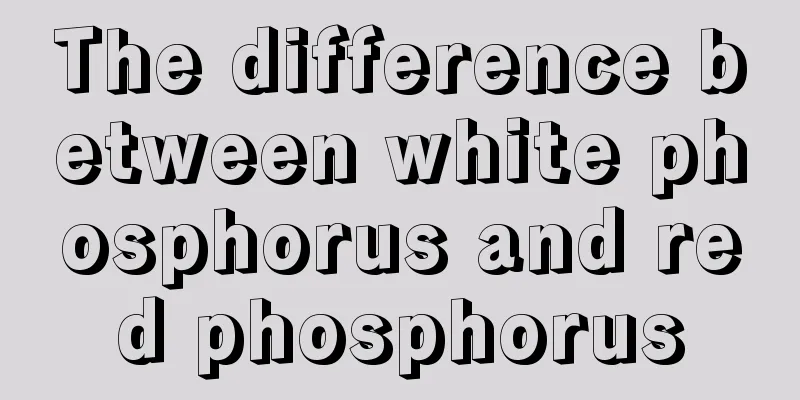The difference between white phosphorus and red phosphorus

|
We usually see that white phosphorus and red phosphorus are some raw materials used in many industries nowadays, because these raw materials can help industrial processing and proceed smoothly. The loss of these raw materials will make the industry unable to start work normally. This is also what many people pay attention to in normal times. No matter what the difference is between the two, they can be used in different agricultural and industrial aspects. Basic Uses of White Phosphorus Although white phosphorus is dangerous, it also has many uses. White phosphorus is used industrially to prepare high-purity phosphoric acid. White phosphorus is flammable and produces smoke (P4O10) and fog (P4O10 combines with water vapor to form foggy substances such as H3PO4). It is often used in the military to make smoke bombs and incendiary bombs. White phosphorus can also be used to make red phosphorus, tetraphosphorus trisulfide, organophosphates, incendiary bombs, rodenticides, etc. Yellow phosphorus, also known as white phosphorus, is a white to light yellow brittle waxy solid with a melting point of 44.1°C, a boiling point of 280°C, and a density of 1.82 g/cm3. White phosphorus is very active and must be stored in water. If a person inhales 0.1 grams of white phosphorus, he will be poisoned and die. White phosphorus turns into red phosphorus when heated to 250°C or exposed to light in the absence of air. Red phosphorus is non-toxic and will not catch fire until heated to above 400°C. Under high pressure, white phosphorus can be transformed into black phosphorus, which has a layered network structure, is conductive, and is the most stable allotrope of phosphorus. Applications of Red Phosphorus 1. Used in the manufacture of matches, pesticides, and in organic synthesis. 2. Phosphorus is divided into yellow phosphorus and red phosphorus. Yellow phosphorus (also known as white phosphorus) is used in pesticide production. It is the starting material for preparing all phosphorus-containing pesticide intermediates. It reacts with sulfur to obtain phosphorus pentasulfide and reacts with chlorine to obtain phosphorus trichloride, which can then produce a series of other phosphorus-containing intermediates. In addition, yellow phosphorus is mainly used to produce phosphoric acid, and a small amount is used to produce red phosphorus and phosphorus pentoxide. It is used in the military to manufacture incendiary bombs, signal flares, etc. It is also used in the production of ferrophosphorus alloys as well as in the pharmaceutical, organic raw materials and other industries. 3. Used in the preparation of semiconductor compounds and as dopants for semiconductor materials. This product can be used to flame retard polyolefins, polystyrene, polyester, nylon, polycarbonate, polyoxymethylene, epoxy resin, unsaturated resin, rubber, textiles, etc. It is particularly effective in flame retardant of oxygen-containing polymers such as polyethylene terephthalate, polycarbonate and phenolic resin. Compared with other phosphorus flame retardants, the same mass of red phosphorus can produce more phosphoric acid, which can cover the surface of the flame-retardant material and accelerate the dehydration and carbonization on the surface of the material to form a liquid film and a carbon layer that can separate external oxygen, volatile combustibles and heat from the internal polymer matrix to interrupt combustion. Since red phosphorus requires a smaller amount to achieve the same flame retardant requirements, and red phosphorus has a high melting point and poor solubility, some physical properties of polymers flame-retarded with red phosphorus are better than those of similar polymers made with general flame retardants. The use of red phosphorus and halogen flame retardants can improve the flame retardant efficiency. 4. Used in the manufacture of fireworks, as well as aluminum phosphide, phosphorus pentoxide, phosphorus trichloride, etc. It is the raw material for producing organophosphorus pesticides. The metallurgical industry is used to manufacture phosphor bronze sheets. It is also used for deacidification of light metals and pharmaceutical production. |
>>: Serum progastrin-releasing peptide
Recommend
Is blood pressure 114 normal?
Blood pressure is generally divided into two type...
Characteristics of pain in gastric cancer
I am very happy to serve you and see your problem...
How to care for a lymphoma patient at home
Lymphoma is a serious disease. To save the life o...
The treatment of early rectal cancer mainly relies on surgery
The treatment of rectal cancer must be timely and...
Can a Chinese herbal medicine cure liver cancer?
Can a Chinese herbal medicine cure liver cancer? ...
Be careful of eight diseases in winter health preservation
①Digestive system diseases In winter, many people...
Should I use air cushion or powder to touch up my makeup?
There is a difference between air cushion and pre...
How to treat blackheads and acne
Many people have certain things growing on their ...
What should be paid attention to in the treatment of lung cancer? Three key points of lung cancer treatment
Nowadays, there are many lung cancer patients, mo...
4 folk remedies for treating gallbladder cancer
Gallbladder cancer is a malignant tumor. The folk...
How long does it usually take for gallbladder cancer to recur
What are the treatments for recurrence of gallbla...
Can passion fruit be eaten directly?
Passion fruit is an oval-shaped fruit that is pop...
How to treat Barrett's esophagitis?
The cause of Barrett's esophagitis is still u...
How to check for kidney deficiency
Kidney deficiency is a disease that can be detect...
How long is the life expectancy of early prostate cancer? What are the early symptoms of prostate cancer?
Many people are very afraid of getting prostate c...









